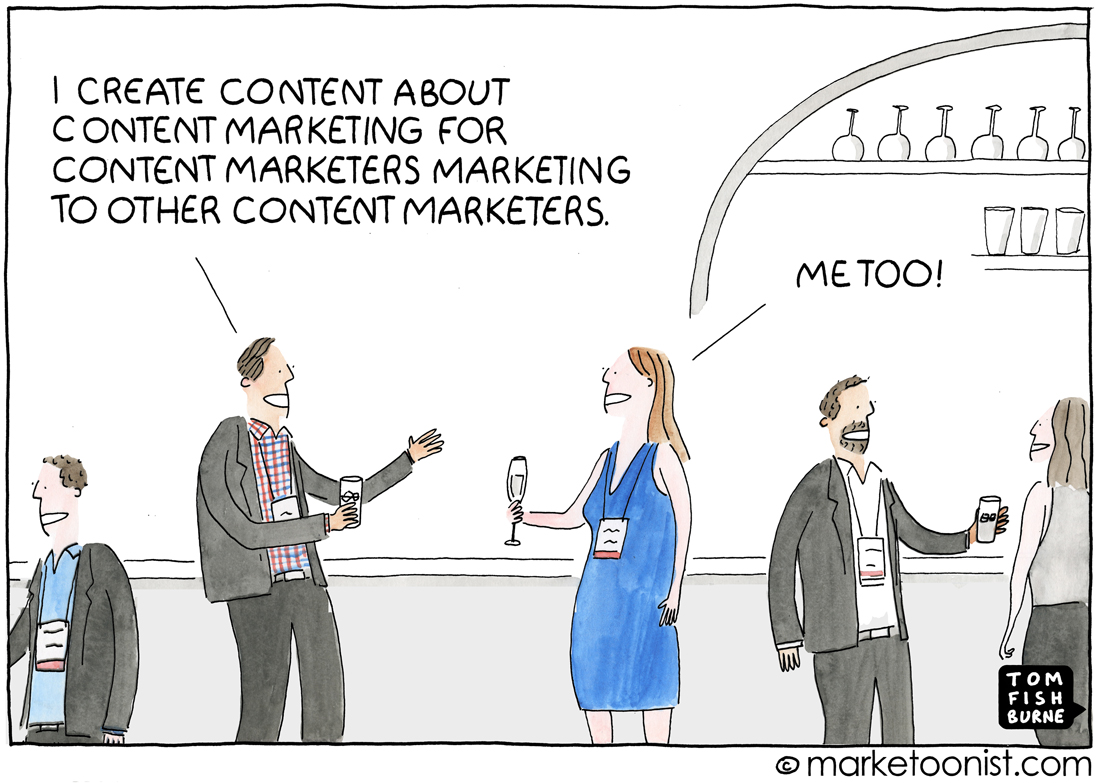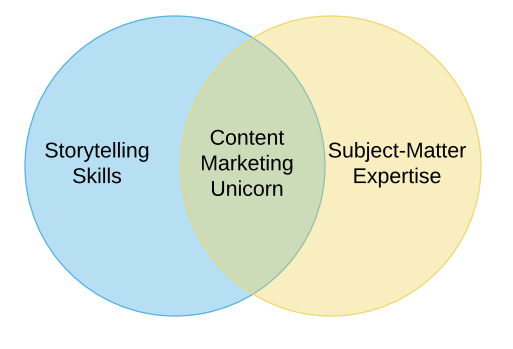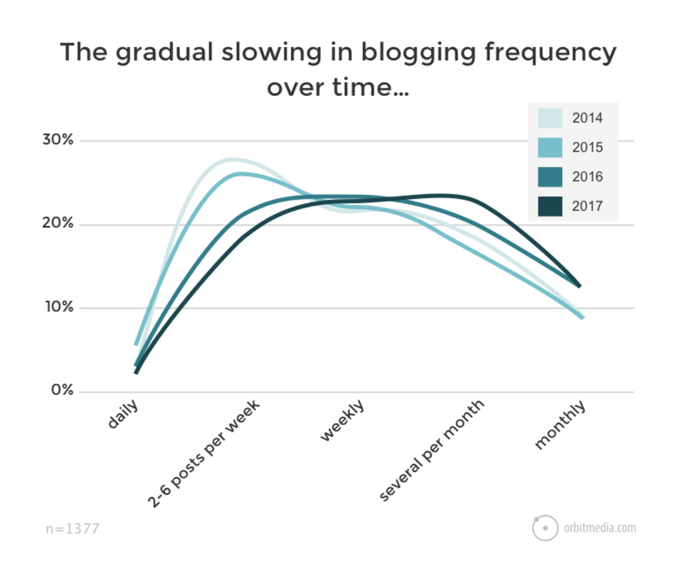Ask a Content Strategist
What Are 2018’s Biggest Content Marketing Trends?
What big content marketing trends do you see for next year?
-Jake, New York
As I sat down to write a navel-gazing trends piece for the fifth straight year, I couldn’t help but think of this cartoon by The Marketoonist for two reasons.

1. This cartoon is way too real. I own that outfit. I’ve had that exact conversation at six different conferences this year. I don’t want to come off as self-centered, but I’m pretty sure The Marketoonist is using me as a muse.
2. This cartoon illustrates why the content strategy echo chamber is so problematic. As I wrote in August, this silo-ing of “content marketing” as a special, separate activity within organizations has caused massive growing pains for the industry. Preaching to the converted is a waste of our time.
So as we talk about the big trends that’ll transform content marketing in 2018, let’s look outside the echo chamber.
1. The content operations shake-up
The hardest part of content marketing isn’t starting a blog or crafting a clever social media graphic. It’s figuring out how to use content in a way that makes every interaction with your customers more effective—while simultaneously overcoming bureaucratic headaches.
Inside large organizations, pulling that off requires an incredible amount of internal coordination and buy-in. You need to assess the content needs of every department and figure out how to build a content machine that’ll pump out the high-quality assets they need. Then you need to figure out how to deliver all that content to the people you want to reach.
This means asking big questions like:
- How do we create a system that lets stakeholders make requests and avoid email chains from hell?
- How do we locate all outdated or low-quality content and get it out of circulation?
- How do we surface relevant content to the right people?
- What key KPIs should we track to measure success and justify this significant investment?
- Who the heck is in charge?
I have conversations with marketers every week about tackling these challenges. The good news is these conversations now include more marketing leaders, who are taking content seriously. I advise them to focus on three big areas.
Content Strategy
Content strategy is much more than coming up with a bunch of story ideas and populating an editorial calendar. It starts with examining organizational needs. (What business goals do you hope to impact through content, and which are most important?) If you’re a brand-driven organization, for instance, your content goals will level up to brand marketing objectives, and the brand marketing team will likely make final decisions about what to produce.
Next, you need to conduct a content audit to identify what assets you can repurpose and what needs to go. Then you have to put in the time to understand your audience personas and the content they crave, which will help you figure how to differentiate yourself from the competition.
Most importantly, you need a plan of attack for getting that content to people through the right channels at the right time. That plan should contain a proper framework for approval workflows (who needs to sign off?), governance (how can we make sure we won’t get sued?) and comprehensive brand and style guides.
Taken altogether, that’s your content strategy.

Technology
You can’t manage an enterprise content operation over email and Google Drive. It’s like trying to manage your sales operation in Excel. It may be free, but it’s a huge waste of money when you factor in all the inefficiency that comes with it.
By this point, a central content marketing platform that bring your teams together to manage creation, activation, and optimization is just table stakes. You also need your content analytics set up properly to measure the impact of your content. Using a simple setup with Google Analytics and Marketo could work fine, but you need to make sure the platforms talk to each other so you can track how top-of-funnel engagement impacts down-funnel conversions.
On top of that, there are a whole slew of SEO and competitive benchmarking tools that we’re in love with. But if I told you what they were, my content strategy team would actually kill me.
Creative Talent
Having the greatest strategy and tech stack in the world doesn’t mean anything without talented content creators who can communicate with your target audience. I expect companies to put a lot of effort into finding those who have that beautiful combination of subject-matter expertise and storytelling skills.

The through line here is that content marketing is extremely difficult. It takes a lot of time, effort, and hard work. Anyone who tells you there’s an easy way to build a world-class content operation is full of it.
Over the last few months, I’ve witnessed a wave of companies flipping the switch and committing to making content work. The journey is hard, but as industry leaders like GE, Amex, and Chase will tell you, the payoff is worth it.
2. The courage to avoid “me-too” content strategies
Last week, BuzzSumo’s Steve Rayson published fascinating research that shows an inverse relationship between the number of posts published on a particular topic and the average shares each individual piece gets.
Take influencer marketing as an example. It’s exploded as a topic over the last couple of years, to the point that over 1,000 stories about influencer marketing are published each month. But on Twitter, the average number of shares per piece has plummeted.

In early 2015, influencer marketing was still somewhat novel, and the folks writing about it tended to be industry leaders and exciting startups riding the crest of the influencer marketing wave. But then a bunch of copycat content creators jumped on the bandwagon, writing the same generic how-to listicles. As a result, the shares plummet because only about 5 percent of the content says something original.
Mark Schaefer termed this phenomenon “content shock.” Being late to a content topic is like being one the last people to buy a hot stock—it seems like a safe choice, but in reality, the risk of failure is huge. Or put another way, Adidas would never copy “Just Do It” as a slogan. Microsoft wouldn’t try to co-opt “Think Different.” But when it comes to articles, videos, and white papers, brands seem more than happy to copy each other.
That doesn’t mean that you need to avoid a topic just because it’s saturated. The topic of content marketing has been hit hard by content shock over the past few years. It’s a hell of a lot harder to break through with a content marketing story today than when I took over The Content Strategist four years ago. But that doesn’t mean that we’re going to pivot and go all-in on Bitcoin coverage.
The challenge is to anticipate what’s next in your industry. For us, that means focusing more on topics like content marketing AI, data-driven content strategies, and content’s role in the customer experience. Internally, our mantra is that we have to both anticipate where the industry is headed and also help drive it there.
When it comes to content, a lot of marketers’ instinct is to do what’s already proven to work. But as the data shows, this approach is likely to fail.
3. Fewer stories, better content
Per research by Orbit media, the publishing frequency of top bloggers over the past few years has decreased while the average length of their pieces has increased. In other words, the best online writers have discovered that the winning formula is publishing fewer posts that are far more in-depth.

I’ve been strongly advising our clients to focus on creating breakthrough stories and invest more resources into distributing them to the right people—particularly through paid social.
You need breakthrough content because simply getting people to click on your content isn’t enough. You have to capture their attention. You need to teach them something. You need to wow them. And when a story can do that, you need to make sure your target audience sees it.
It’s just advertising 101. When Budweiser spends big money to make heartwarming “Puppy Love” commercials, the marketing team doesn’t just post it on the website and hope people find it. They buy as much media behind it as possible.
That awesome interactive infographic, captivating short-form motion video, and thought-provoking white paper you publish works the same way. You need to milk that content for everything it’s worth.
That’s how you avoid content shock—and stun your competitors.
Joe Lazauskas is the director of content strategy at Contently. The Storytelling Edge, his book with Contently co-founder Shane Snow, is available for pre-order now. Ask him your most pressing content strategy questions here.
Image by iStockphotoGet better at your job right now.
Read our monthly newsletter to master content marketing. It’s made for marketers, creators, and everyone in between.




